
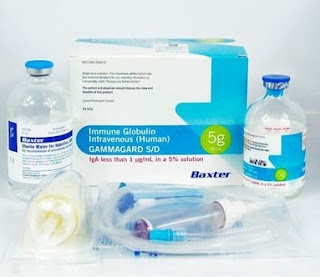
ГАММАГАРД С/Д 5 г, ПОРОШОК І РОЗЧИННИК ДЛЯ ПРИГОТУВАННЯ РОЗЧИНУ ДЛЯ ІНФУЗІЙ

Запитайте лікаря про рецепт на ГАММАГАРД С/Д 5 г, ПОРОШОК І РОЗЧИННИК ДЛЯ ПРИГОТУВАННЯ РОЗЧИНУ ДЛЯ ІНФУЗІЙ

Інструкція із застосування ГАММАГАРД С/Д 5 г, ПОРОШОК І РОЗЧИННИК ДЛЯ ПРИГОТУВАННЯ РОЗЧИНУ ДЛЯ ІНФУЗІЙ
Введення
Опис: інформація для користувача
ГАММАГАРД С/Д 5 г, порошок і розчинник для інфузійної розв'язки
Нормальна людська імуноглобулін
Прочитайте уважно весь опис перед початком використання цього лікарського засобу, оскільки він містить важливу інформацію для вас.
- Збережіть цей опис, оскільки вам може знадобитися знову його прочитати.
- Якщо у вас виникли питання, проконсультуйтеся з вашим лікарем або фармацевтом.
- Якщо ви відчуваєте побічні ефекти, проконсультуйтеся з вашим лікарем, фармацевтом або медсестрою, навіть якщо це побічні ефекти, які не вказані в цьому описі. Див. розділ 4.
Зміст опису
- Що таке ГАММАГАРД С/Д і для чого він використовується
- Що потрібно знати перед початком використання ГАММАГАРД С/Д
- Як використовувати ГАММАГАРД С/Д
- Можливі побічні ефекти
- Збереження ГАММАГАРД С/Д
- Зміст упаковки та додаткова інформація
1. Що таке ГАММАГАРД С/Д і для чого він використовується
ГАММАГАРД С/Д належить до класу лікарських засобів, званих імуноглобулінами. Ці лікарські засоби містять людські антитіла, які також присутні в крові. Антитіла допомагають боротися з інфекціями. Лікарські засоби, подібні до ГАММАГАРД С/Д, використовуються, коли в крові не достатньо антитіл. Ці пацієнти часто страждають від інфекцій. ГАММАГАРД С/Д також можна використовувати, коли потрібно додаткові антитіла для лікування певних запальних розладів (автоімунних захворювань).
ГАММАГАРДС/Д5 г використовується для
Лікування пацієнтів, які не мають достатньо антитіл (лікування заміщення). Існує п'ять груп:
- Пацієнти з вродженою недостатністю виробництва антитіл (первинні імунодефіцитні синдроми (ПІД)) як:
- агаммаглобулінемія або гіпогаммаглобулінемія,
- змінена імунодефіцитна хвороба,
- важкі комбіновані імунодефіцити,
- Синдром Віскотта-Олдрича
- Пацієнти з раком крові (хронічний лімфолейкоз), який викликає недостатність виробництва антитіл та повторювані інфекції, коли профілактичне лікування антибіотиками було неефективним.
- Пацієнти з раком кістового мозку (мієлома) та недостатністю виробництва антитіл з повторюваними інфекціями, у яких не було відповіді на вакцинацію проти певних бактерій (пневмококів).
- Діти та підлітки (0-18 років) з вродженим СНІДом та частими інфекціями.
- Пацієнти з низькою виробництвом антитіл після трансплантації кісткового мозку від іншої людини.
Лікування пацієнтів з певними запальними розладами (імуномодуляторний ефект). Існує три групи:
- Пацієнти, у яких не достатньо тромбоцитів у крові (ідіопатична тромбоцитопенічна пурпура) та з високим ризиком кровотечі або які будуть піддані хірургічній операції в найближчому майбутньому.
- Пацієнти з хворобою, яка викликає множинну запалення різних органів тіла (хвороба Кавасакі).
- Пацієнти з хворобою, яка характеризується множинним запаленням нервів всього тіла (синдром Гієна-Барре).
2. Що потрібно знати перед початком використання ГАММАГАРД С/Д
Не використовуйтеГАММАГАРДС/Д
- Якщо ви алергічні (гіпersenситивні) до імуноглобулінів або до будь-якого іншого компонента цього лікарського засобу (включаючи розділ 6).
- Якщо у вас недостатність імуноглобуліну А. Ви можете мати антитіла проти імуноглобуліну А в крові. ГАММАГАРД С/Д містить дуже малі кількості імуноглобуліну А, і ви можете розвинути алергічну реакцію.
Попередження та застереження
Період контролю, необхідний під час інфузії
- Ви будете піддаватися ретельному контролю під час періоду інфузії ГАММАГАРД С/Д, щоб уникнути алергічної реакції. Ваш лікар буде стежити за тим, щоб швидкість інфузії ГАММАГАРД С/Д була адекватною для вашого випадку.
Може бути підвищений ризик побічних ефектів:
- якщо ГАММАГАРД С/Д вводиться з високою швидкістю,
- якщо у вас є розлад, який характеризується низьким рівнем антитіл у крові (гіпо- або агаммаглобулінемія),
- якщо ви не приймали цього лікарського засобу раніше або
- якщо пройшов тривалий період (наприклад, кілька тижнів) з моменту останнього введення.
У цих випадках ви будете піддаватися ретельному контролю під час інфузії та протягом години після закінчення інфузії, оскільки може бути підвищений ризик побічних ефектів.
Якщо ви нещодавно приймали ГАММАГАРД С/Д, вас буде спостерігати тільки під час інфузії та протягом至少 20 хвилин після інфузії.
Коли потрібно зупинити або зменшити швидкість інфузії
У рідких випадках ваш організм може бути сенсибілізований до лікарських засобів, які містять антитіла. Це може статися особливо якщо у вас недостатність імуноглобуліну А. У цих рідких випадках можуть виникнути алергічні реакції, такі як раптове зниження артеріального тиску або шок, навіть якщо ви раніше приймали лікування лікарськими засобами, які містять антитіла.
- Якщо ви відчуваєте будь-які з цих симптомів, негайно повідомте вашому лікарю або медсестрі:
- Раптові свистки, труднощі з диханням або стиск у грудній клітці
- Головний біль
- Лихоманка
- Набухання повік, обличчя, губ або кровоносних судин
- Бульбуси або червоні плями з свербінням на шкірі
- Свербіння по всьому тілу
Залежно від рішення вашого лікаря можна зменшити швидкість або зупинити інфузію.
Особливі групи пацієнтів
Ваш лікар повинен бути особливо обережним, якщо у вас надмірна вага, ви старші, ви діабетик, ви імобілізовані, якщо ви використовуєте естрогени, маєте постійну судинну сонду або маєте схильність до тромбозу.
Ваш лікар буде ретельно спостерігати за вами, якщо у вас:
- високий артеріальний тиск
- низький об'єм крові (гіповолемія)
- збільшення в'язкості крові або проблеми з кровоносними судинами (судинні захворювання, включаючи серцевий викид або тромботичні епізоди)
- збільшена коагуляція або розлади коагуляції.
У цих випадках імуноглобуліни можуть збільшити ризик інфаркту міокарда, інсульту, легеневої емболії або глибокої венозної тромбози, хоча це відбувається дуже рідко.
Повідомте вашому лікарю, якщо ви діабетик.
Цей лікарський засіб містить глюкозу. ГАММАГАРД С/Д не містить сукрози чи мальтози.
Пацієнти з цукровим діабетом повинні знати, що 5% розв'язка ГАММАГАРД С/Д містить 400 мг глюкози на грам імуноглобуліну. Пацієнт вагою 70 кг, який отримує дозу 1 г/кг імуноглобуліну, отримує 28 грамів глюкози, що може вплинути на рівень цукру в крові.
Ваш лікар також буде особливо обережним
- якщо у вас були проблеми з нирками
- якщо ви приймаєте лікарські засоби, які можуть пошкодити нирки (нефротоксичні лікарські засоби), оскільки існує дуже низький ризик гострого ниркового захворювання. Повідомте вашому лікарю, якщо у вас були проблеми з нирками.
Вміст білка може збільшуватися, що призводить до підвищення в'язкості крові
Інформація про оригінальний матеріалГАММАГАРД С/Д
ГАММАГАРД С/Д виготовляється з людської плазми (рідкої частини крові). Коли лікарські засоби виготовляються з крові або плазми людини, необхідно вжити ряд заходів для запобігання можливому передаванню інфекцій пацієнтам. Ці заходи включають ретельний відбір донорів крові та плазми для забезпечення виключення донорів з ризиком інфекції та аналіз кожної донованої плазми для виявлення можливих вірусів або інфекцій. Виробники цих продуктів також включають ряд стадій при обробці крові або плазми, які можуть інактивувати або видалити віруси. Незважаючи на ці заходи, при введенні лікарських засобів, приготовлених з крові або плазми людини, не можна повністю виключити можливість передавання інфекцій. Це також стосується невідомих або новоутворених вірусів та інших типів інфекцій.
Захід, прийнятий для боротьби з вірусами, вважається ефективним для вірусів, які мають оболонку, таких як ВІЛ, вірус гепатиту Б (ВГБ) та вірус гепатиту С (ВГС), і для вірусу гепатиту А (ВГА) без оболонки. Захід, прийнятий, може мати обмежену цінність для вірусів без оболонки, таких як парвовірус В19.
Імуноглобуліни не були пов'язані з інфекціями гепатиту А або парвовірусом В19, можливо, тому що антитіла проти цих інфекцій, які присутні в продукті, є захисними.
Рекомендується кожен раз, коли вводиться ГАММАГАРД С/Д, робити запис про назву лікарського засобу та номер партії для зберігання реєстру використаних партій.
Використання ГАММАГАРД С/Д з іншими лікарськими засобами
Повідомте вашому лікарю або фармацевту, якщо ви приймаєте, нещодавно приймали або можете приймати інші лікарські засоби або якщо ви були вакциновані протягом останніх шести тижнів.
Інфузія імуноглобулінів, таких як ГАММАГАРД С/Д, може змінити ефективність деяких вакцин живих вірусів, таких як вакцина проти кору, краснухи, епідемічного паротиту та вітряної віспи. Тому після введення цих лікарських засобів може знадобитися чекати до трьох місяців, перш ніж отримати вакцину живих вірусів. Можливо, знадобиться чекати до одного року після отримання імуноглобулінів, перш ніж отримати вакцину проти кору.
Вплив на аналізи крові
ГАММАГАРД С/Д містить велику кількість різних антитіл, деякі з яких можуть впливати на аналізи крові. Якщо вам проводять аналіз крові, повідомте аналітику або вашому лікарю, що вам було введено ГАММАГАРД С/Д.
Введення ГАММАГАРД С/Д може привести до хибно-позитивних результатів у тестах, які залежать від виявлення бета-Д-глюканів для діагностики грибкових інфекцій; це може тривати протягом тижнів після інфузії продукту.
Вагітність, лактація та фертильність
Якщо ви вагітні або годуєте грудьми, вважаєте, що можете бути вагітною або плануєте вагітність, проконсультуйтеся з вашим лікарем або фармацевтом перед використанням цього лікарського засобу.
- Не проводилися клінічні дослідження ГАММАГАРД С/Д у вагітних жінок або під час лактації. Роки клінічного досвіду з лікарськими засобами, які містять антитіла, показали, що не слід очікувати шкідливих ефектів під час вагітності чи для дитини.
- Якщо ви годуєте грудьми, антитіла ГАММАГАРД С/Д можуть бути присутні в грудному молоці. Тому ваша дитина може бути захищена від певних інфекцій.
- Ефекти ГАММАГАРД С/Д на фертильність не встановлені.
Відповідність для керування транспортними засобами та використання машин
Пацієнти можуть відчувати реакції (наприклад, головокружіння або нудоту) під час лікування ГАММАГАРД С/Д, які можуть впливати на здатність керувати транспортними засобами та використовувати машини.
Якщо це відбувається, чекайте, поки реакції не зникнуть.
Гаммагард С/Д 5 г містить натрій та глюкозу
Цей лікарський засіб містить 334 мг натрію (основної речовини кухонної солі) в кожній флаконі. Це відповідає 17% від максимальної добової норми споживання натрію для дорослого.
Цей лікарський засіб містить глюкозу. Пацієнти з цукровим діабетом повинні знати, що 5% розв'язка ГАММАГАРД С/Д містить 400 мг глюкози на грам імуноглобуліну. Пацієнт вагою 70 кг, який отримує дозу 1 г/кг імуноглобуліну, отримує 28 грамів глюкози, що може вплинути на рівень цукру в крові.
3. Як використовувати ГАММАГАРД С/Д
ГАММАГАРД С/Д призначений для внутрішньовенної інфузії (введення в вену). Його буде вводити ваш лікар або медсестра. Доза та частота інфузії можуть змінюватися залежно від вашого стану та ваги тіла.
На початку інфузії ви отримаєте ГАММАГАРД С/Д з низькою швидкістю. Ваш лікар може поступово збільшувати швидкість інфузії залежно від того, як ви її переносите.
Використання у дітей
У дітей (0-18 років) використовуються ті самі показання, дози та частота інфузії, що й у дорослих.
Якщо ви використовуєте більшеГАММАГАРДС/Д, ніж потрібно
Якщо ви отримуєте більше ГАММАГАРД С/Д, ніж потрібно, кров може загустіти (гіпервіскозність). Чим більше кров загустіє, тим важче буде її транспортування через судини вашого організму, тому менше кисню буде доставлено до життєво важливих органів, таких як мозок, легені тощо. Це може статися особливо якщо ви пацієнт групи ризику (наприклад, пацієнт похилого віку або пацієнт з проблемами нирок чи серцевими захворюваннями). Переконайтеся, що ви приймаєте достатньо рідини, щоб не допустити зневоднення, і повідомте вашому лікарю, якщо у вас виникнуть проблеми зі здоров'ям.
У разі передозування або випадкового введення зверніться до Токсикологічної служби. Телефон 915 620 420.
4. Можливі побічні ефекти
Як і всі лікарські засоби, ГАММАГАРД С/Д може викликати побічні ефекти, хоча не всі люди їх відчувають. Однак можливі побічні ефекти можна зменшити, зменшивши швидкість інфузії.
Наступні побічні ефекти можуть виникнути зазвичай після лікування імуноглобулінами (лікарськими засобами, подібними до ГАММАГАРД С/Д):
- Часті (можуть впливати до 1 особи з 10): озноб, головний біль, лихоманка, блювота, нудота.
- Нечасті (можуть впливати до 1 особи з 100): легкий біль у нижній частині спини.
- Рідкі (можуть впливати до 1 особи з 1000): випадки раптового зниження артеріального тиску, симптоми, подібні до екземи (тимчасові шкірні реакції).
- Частота невідома (не може бути оцінена на основі доступних даних): алергічні реакції, навіть у пацієнтів, які не мали реакцій на попередні інфузії; тимчасове запалення оболонок мозку (асептичний менінгіт); тимчасове зниження кількості червоних кров'яних тілечок; збільшення тимчасових показників функції печінки (трансаміназ) та збільшення вмісту креатиніну в крові та гостре ниркове захворювання; утворення кров'яних згустків у венах, які мали наслідком інфаркт міокарда, інсульт, пошкодження легенів та глибоку венозну тромбоз; біль у суглобах; низький артеріальний тиск.
Наступні побічні ефекти були зареєстровані деякими пацієнтами під час клінічних досліджень ГАММАГАРД С/Д та під час постмаркетингового досвіду:
- Часті (можуть впливати до 1 особи з 10): головний біль, червоність, нудота, блювота, втома, озноб, лихоманка.
- Нечасті (можуть впливати до 1 особи з 100): грип, тривога, агітація, надмірна сонливість, розмита зір, відчуття серцебиття, труднощі з диханням, носова кровотеча, діарея, біль у верхній частині живота, нездужання шлунка, запалення ротової порожнини, свербіння, висипи на шкірі, холодний пот, надмірна потливість, біль у спині, м'язові спазми, біль у руках і ногах, біль у грудній клітці, нездужання у грудній клітці, незвичайні відчуття, відчуття холоду, відчуття жару, симптоми, подібні до грипу, червоність у місці ін'єкції, витік лікарського засобу з місця ін'єкції, біль у місці ін'єкції, відчуття нудоти/блювоти, біль, підвищений артеріальний тиск, порушення артеріального тиску.
- Частота невідома (не може бути оцінена на основі доступних даних): запалення оболонок мозку, не викликані бактеріальною інфекцією, руйнування червоних кров'яних тілечок, зниження кількості червоних кров'яних тілечок, зниження кількості тромбоцитів, запалення лімфатичних вузлів, алергічні реакції будь-якої тяжкості, такі як анафілаксія, нервозність, головокружіння, незвичайні відчуття на шкірі, мимовільні рухи, судоми, крововиливи в мозок, інсульт (транзиторний), мігрень, втата свідомості, світлобоязнь, порушення зору, біль в оці, закриття центральної судини ока, інфаркт міокарда, синюшність шкіри, підвищений серцевий ритм, зниження серцевого ритму, підвищений артеріальний тиск, блідість, низький артеріальний тиск, запалення вен, закриття кров'яних судин, кашель, стиск у горлі, зниження рівня кисню в крові, гіпервентиляція, свистіння в грудній клітці, спазми дихальних шляхів, закриття кров'яних судин легенів, рідини в легенях, порушення травлення, біль у животі, запалення печінки (не трансмisible), червоність шкіри, висипи на шкірі, запалення шкіри, алергічна реакція шкіри, біль у м'язах і суглобах, гостре ниркове захворювання, загальна слабкість, набухання тканин тіла, реакції в місці ін'єкції та інфузії, позитивний результат тесту Кумбса.
Звіт про побічні ефекти
Якщо ви відчуваєте будь-які побічні ефекти, повідомте вашому лікарю, фармацевту або медсестрі, навіть якщо це побічні ефекти, які не вказані в цьому описі. Ви також можете повідомити про них безпосередньо через Іспанську систему фармакологічного нагляду за лікарськими засобами для людини: www.notificaRAM.es.
Повідомляючи про побічні ефекти, ви можете допомогти надати більше інформації про безпеку цього лікарського засобу.
5. Збереження ГАММАГАРД С/Д
- Тримати поза зоною досяжності дітей.
- Не використовувати цей лікарський засіб після закінчення терміну придатності, вказаного на упаковці після CAD. Термін придатності - останній день місяця.
- Не використовувати, якщо спостерігаються частинки або забарвлення.
- Не зберігати при температурі вище 25°C.
- Не заморожувати.
Тримати упаковку в зовнішній обгортці для захисту від світла.
6. Зміст упаковки та додаткова інформація
СкладГАММАГАРД С/Д
Активний інгредієнт ГАММАГАРД С/Д - нормальна людська імуноглобуліна.
ГАММАГАРД С/Д можна реконструювати з стерильною водою для ін'єкційних препаратів як 5% (50 мг/мл) або 10% (100 мг/мл) розчин білка. Як мінімум 90% складає імуноглобулін G (IgG).
Інші компоненти - людська альбумін, гліцин, хлорид натрію та глюкоза моногідрат.
Вигляд продукту та вміст упаковки
ГАММАГАРД С/Д - це білий або слабо-жовтий лioфілізований порошок, практично вільний від чужорідних частинок. ГАММАГАРД С/Д доступний у упаковках по 5 г та 10 г.
Кожна упаковка містить
- флакон з порошком, 5 г
- 96 мл води для ін'єкційних препаратів
- стерильний пристрій для перекачування
- стерильний набір для введення з фільтром
Власник дозволу на продаж та відповідальний за виробництво:
Власник дозволу на продаж:
Baxalta Innovations GmbH
Industriestrasse 67
1221 Відень
Австрія
Відповідальний за виробництво:
Baxalta Belgium Manufacturing SA
Boulevard René Branquart, 80 (Lessines)
B-7860-Бельгія
Місцевий представник:
Takeda Farmacéutica España S.A.
Calle Albacete, 5, planta 9ª,
Edificio Los Cubos
28027 Мадрид
Іспанія
Тел: +34 91 790 42 22
Цей листок затверджено в січні 2021 року
Детальна та актуальна інформація про цей лікарський засіб доступна на сайті Агентства з лікарських засобів та медичних продуктів Іспанії (AEMPS) http://www.aemps.gob.es/
---------------------------------------------------------------------------------------------------------------------------
ЦЯ ІНФОРМАЦІЯ ПРИДНАЗНАЧЕНА ТИЛЬКИ ДЛЯ ЛІКАРІВ ЧИ ПРАЦІВНИКІВ ОХОРОНИ ЗДОРОВ'Я
Особливі заходи під час зберігання
Встановлено хімічну та фізичну стабільність ГАММАГАРД С/Д після реконструкції протягом 24 годин при кімнатній температурі. З мікробіологічної точки зору продукт повинен використовуватися негайно, час і умови зберігання перед використанням залежать від користувача і зазвичай не повинні перевищувати 24 години при температурі 2-8°C, коли реконструкція проводиться в контрольованих і валідованих асептичних умовах.
Реконструкція: Використовувати асептичну техніку:
Після реконструкції вводяться лише прозорі або слабо опалесцентні та безбарвні чи жовтуваті розчини.
Встановити флакон з порошком та флакон з водою для ін'єкційних препаратів (розчинник) при кімнатній температурі. Підтримувати цю температуру до завершення розчинення.
- Розчин 5%
- Зняти захисні ковпачки з флаконів та очистити пробки розчином геріциду.
- Зняти захисний ковпачок, який закриває голку пристрою перекачування. Не торкатися голки.
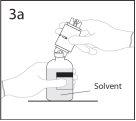
3а. Помістити флакон з розчинником на гладку поверхню.
Використовувати відкритий кінець голки для
проколювання флакону з розчинником через центр пробки.
ПОПЕРЕДЖЕННЯ: якщо голку не ввести в центр
пробки, вона може відокремитися і втрачиться вакуум.
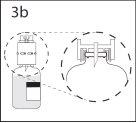
3б. Перевірити, чи повністю вставлений горлечок флакону в пристрій, натиснувши пристрій перекачування.
Зняти захисний ковпачок, який закриває інший кінець голки, тримаючи пристрій перекачування. Не торкатися голки.
- Тримати флакон з розчинником з підключеним пристроєм перекачування під кутом до флакону з порошком, щоб запобігти витіканню розчинника.
Примітка: не ставити флакон з розчинником вниз, оскільки розчинник може витекти.
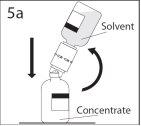 5а. Проколоти флакон з порошком через центр пробки, швидко перевертаючи флакон з розчинником, щоб уникнути витікання розчинника.
5а. Проколоти флакон з порошком через центр пробки, швидко перевертаючи флакон з розчинником, щоб уникнути витікання розчинника.
ПОПЕРЕДЖЕННЯ: якщо голку не ввести в центр
пробки, вона може відокремитися і втрачиться вакуум.
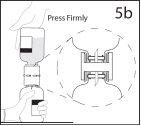 5б. Перевірити, чи повністю вставлений горлечок флакону в пристрій, натиснувши флакон з розчинником.
5б. Перевірити, чи повністю вставлений горлечок флакону в пристрій, натиснувши флакон з розчинником.
- Після того, як весь розчинник перейшов у флакон з порошком, видалити пристрій перекачування та порожній флакон з розчинником. Негайно повернути флакон з концентратом, щоб повністю перемішати вміст.
ПОПЕРЕДЖЕННЯ: не агітувати. Уникати утворення піни.
Після одного використання видалити пристрій перекачування.
- Розчин 10%
- Зняти захисні ковпачки з флаконів та очистити пробки розчином геріциду.
- Для підготовки 10% розчину необхідно витягнути половину об'єму розчинника. Таблиця 2 описує об'єм розчинника, який потрібно витягнути з кожного флакону, щоб отримати 10% розчин перед підключенням пристрою перекачування. Використовуючи асептичну техніку, витягнути непотрібний об'єм розчинника за допомогою стерильного гіподермічного шприца та голки. Видалити шприц та голку, які містять непотрібну кількість розчинника.
- Використовуючи залишковий розчинник у флаконі з розчинником, слідувати крокам 2-6, описаним у розділі А.
ТАБЛИЦЯ 2
5 г
Концентрація флакону
5% Для реконструкції 5% не витягувати жодної кількості розчинника
10% 48 мл
Введення. Використовувати асептичну техніку
Слідувати інструкціям з використання буклету, який супроводжує набір для введення у упаковці. Якщо використовується інший набір для введення, переконатися, що він містить подібний фільтр.
Інструкції з використання та обробки
Продукт повинен бути приведений до кімнатної температури або температури тіла перед використанням.
Повне розчинення повинно бути досягнуто протягом 30 хвилин.
Отриманий розчин повинен бути прозорим або слабо опалесцентним та безбарвним чи жовтуватим. Не використовувати розчини, які є мутними або містять осад. Реконструйований продукт повинен бути візуально перевірений перед введенням, щоб підтвердити відсутність частинок та забарвлення.
Видалення невикористаного лікарського засобу та всіх матеріалів, які були в контакті з ним, повинно проводитися згідно з місцевими нормативами.
Видалити пристрій перекачування після одного використання.
Форма введення
Внутрішньовенно.
Якщо це можливо, рекомендується вводити 10% розчин ГАММАГАРД С/Д через вени ліктьового суглобу. Це може зменшити ймовірність появи незручностей у місці інфузії.
ГАММАГАРД С/Д 5% (50 мг/мл) повинен вводитися внутрішньовенно з початковою швидкістю 0,5 мл/кг/год. Загалом рекомендується, щоб пацієнти, які вперше отримують ГАММАГАРД С/Д або змінюють іншу внутрішньовенну імуноглобулін на ГАММАГАРД С/Д, починали лікування з найнижчої швидкості введення та потім збільшували до максимальної швидкості, якщо раніше вони переносили кілька інфузій з проміжними швидкостями введення.
Якщо це добре переноситься, швидкість введення 5% розчину можна поступово збільшувати до максимальної швидкості 4 мл/кг/год. Коли змінюється з 5% розчину на 10% розчин, швидкість введення 10% розчину повинна бути спочатку низькою, щоб підтримувати порівнянну швидкість введення білка IgG. У багатьох пацієнтів можна поступово збільшувати швидкість введення 10% розчину до 8 мл/кг/год. Швидкість введення буде коригуватися індивідуально згідно з переносимістю пацієнта.
Особливі заходи обережності
Будь-які побічні ефекти, пов'язані з інфузією, повинні бути ліквідовані шляхом зменшення швидкості або зупинки інфузії.
Кожного разу, коли вводиться ГАММАГАРД С/Д, рекомендується вказувати назву та номер партії продукту.
Несумісності
ГАММАГАРД С/Д не повинен змішуватися з іншими лікарськими засобами. Рекомендується вводити ГАММАГАРД С/Д окремо від інших лікарських засобів, які приймає пацієнт.
Рекомендована доза
ПОКАЗАННЯ | ДОЗА | ЧАСТОТА ВВЕДЕННЯ/ІНФУЗІЇ |
Лікування заміщення при первинній імунодефіциті Лікування заміщення при вторинній імунодефіциті Вроджений СНІД Гіпогаммаглобулінемія (< 4 г/л) у пацієнтів, які отримали алогенічний трансплантат гемопоетичних стовбурових клітин | Початкова доза: 0,4 – 0,8 г/кг Продовження: 0,2-0,8 г/кг 0,2-0,4 г/кг 0,2-0,4 г/кг 0,2-0,4 г/кг | кожні 3-4 тижні для досягнення рівня долини IgG не менше 5-6 г/л. кожні 3-4 тижні для досягнення рівня долини IgG не менше 5-6 г/л. кожні 3-4 тижні кожні 3-4 тижні для досягнення рівня долини IgG понад 5 г/л |
Імуномодуляція: Первинна імунна тромбоцитопенія Синдром Гієна-Барре Хвороба Кавасакі | 0,8-1 г/кг або 0,4 г/кг/добу 0,4 г/кг/добу 1,6-2 г/кг або 2 г/кг | перший день, може повторюватися один раз протягом трьох наступних днів під час 2-5 днів під час 5 днів в кілька доз протягом 2-5 днів, разом з ацетилсаліциловою кислотою в одній дозі, разом з ацетилсаліциловою кислотою. |
- Країна реєстрації
- Діючі речовини
- Потрібен рецептТак
- Виробник
- Інформація є довідковою і не є медичною порадою. Перед прийомом будь-яких препаратів обов'язково проконсультуйтеся з лікарем. Oladoctor не несе відповідальності за медичні рішення, прийняті на основі цього контенту.
- Альтернативи до ГАММАГАРД С/Д 5 г, ПОРОШОК І РОЗЧИННИК ДЛЯ ПРИГОТУВАННЯ РОЗЧИНУ ДЛЯ ІНФУЗІЙФорма випуску: РОЗЧИН ДЛЯ ІНФУЗІЙ, ЩО ВВОДИТЬСЯ ІН'ЄКЦІЙНО, 100 мг/млДіючі речовини: immunoglobulins, normal human, for intravascular adm.Виробник: Instituto Grifols S.A.Потрібен рецептФорма випуску: РОЗЧИН ДЛЯ ІНФУЗІЙ, ЩО ВВОДИТЬСЯ ІН'ЄКЦІЙНО, 100 мг/млДіючі речовини: immunoglobulins, normal human, for intravascular adm.Виробник: Instituto Grifols S.A.Потрібен рецептФорма випуску: РОЗЧИН ДЛЯ ІНФУЗІЙ, ЩО ВВОДИТЬСЯ ІН'ЄКЦІЙНО, 100 мг/млДіючі речовини: immunoglobulins, normal human, for intravascular adm.Виробник: Instituto Grifols S.A.Потрібен рецепт
Аналоги ГАММАГАРД С/Д 5 г, ПОРОШОК І РОЗЧИННИК ДЛЯ ПРИГОТУВАННЯ РОЗЧИНУ ДЛЯ ІНФУЗІЙ в інших країнах
Найкращі аналоги з тією самою діючою речовиною та терапевтичним ефектом.
Аналог ГАММАГАРД С/Д 5 г, ПОРОШОК І РОЗЧИННИК ДЛЯ ПРИГОТУВАННЯ РОЗЧИНУ ДЛЯ ІНФУЗІЙ у Польща
Аналог ГАММАГАРД С/Д 5 г, ПОРОШОК І РОЗЧИННИК ДЛЯ ПРИГОТУВАННЯ РОЗЧИНУ ДЛЯ ІНФУЗІЙ у Україна
Лікарі онлайн щодо ГАММАГАРД С/Д 5 г, ПОРОШОК І РОЗЧИННИК ДЛЯ ПРИГОТУВАННЯ РОЗЧИНУ ДЛЯ ІНФУЗІЙ
Консультація щодо дозування, побічних ефектів, взаємодій, протипоказань та поновлення рецепта на ГАММАГАРД С/Д 5 г, ПОРОШОК І РОЗЧИННИК ДЛЯ ПРИГОТУВАННЯ РОЗЧИНУ ДЛЯ ІНФУЗІЙ – за рішенням лікаря та згідно з місцевими правилами.














